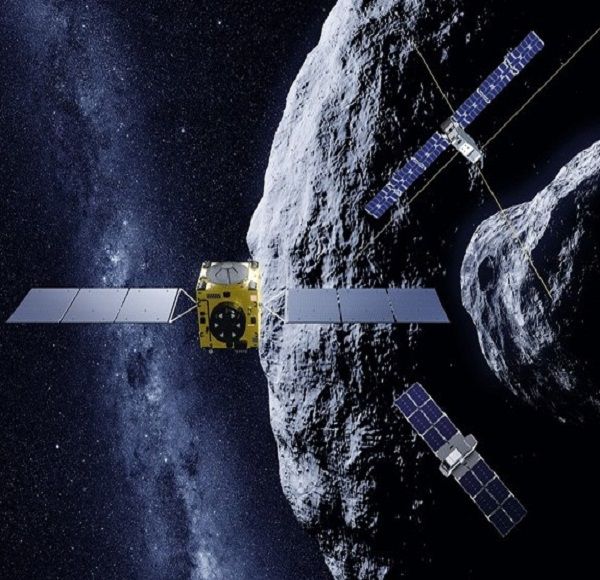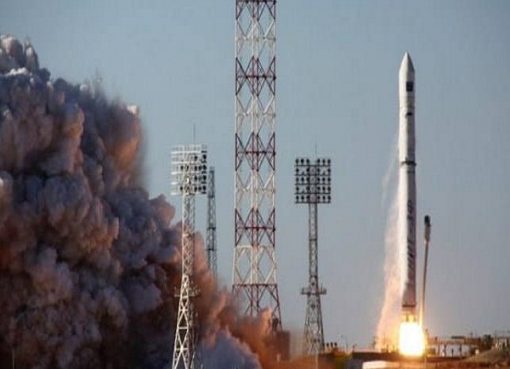The potentially catastrophic consequences of a major asteroid impact have accelerated international efforts to defend the planet.
When the 1998 disaster movie Armageddon told the far-fetched story of a mission into space to destroy a meteor the size of Texas to prevent it from hitting Earth, few would have believed that a real planetary defence system would smash into an asteroid just over a couple of decades later.
The Hollywood blockbuster is riddled with scientific inaccuracies, but its central premise of creating an explosion to knock an asteroid off course played out in our solar system in September last year when Nasa’s Double Asteroid Redirection Test (DART) successfully impacted the asteroid ‘moonlet’ Dimorphos.
It was the first-ever mission to demonstrate an asteroid deflection by changing its motion in space – a so-called kinetic impactor. This had laid the groundwork for a new breed of spacecraft that could one day save humanity from destruction.
Astronomers have ruled out the immediate danger of a ‘global killer’ rock similar to that which wiped out the dinosaurs, but asteroids of around 300m across could flatten a city. Many can’t be detected using conventional telescopes.
The threat of a real life ‘deep impact’ has catalysed a wave of planetary defence R&D activity by space agencies across the world. DART will be followed by the European Space Agency’s (ESA’s) mission Hera, which will launch a spacecraft next year to study the results of the collision. Meanwhile, new high-power telescopes are being built, and Nasa is moving ahead with its development of a spacecraft-mounted telescope designed to hunt for hidden asteroids, including those that lie beyond the Sun.

The Hera mission / ESA
Dr Katie Mack, a theoretical astrophysicist and Hawking chair in cosmology and science communication at the Perimeter Institute for Theoretical Physics in Ontario, Canada, tells E+T: “The kinetic impactor missions are really interesting as a way to test if we could do anything if we saw a big asteroid coming for us.” Although in human history only smaller objects have landed and not had a major impact on human life, she adds: “If we saw something much larger and dangerous coming toward us, and if we have enough notice, then in principle we could do something about it.”
Unheavenly bodies
Small space rocks rain down our planet every day as meteorites and dust. It’s the bigger, heavier asteroids that international space agencies are most worried about.
The object that is thought to have finished off the dinosaurs 67 million years ago ranks pretty high in the devastation stakes. The rock, which was 10-15km wide, smashed into the planet near today’s Yucatán Peninsula in Mexico, triggering a wave of earthquakes, tsunamis and global firestorms. It left behind a 180km-wide, 20km-deep crater.
Fast forward to today and it’s scary to think that there are over 150 asteroids wider than 1km flying close to Earth’s orbit. But before you grab your keys and drive to the nearest bunker, none of them have a significant chance of impacting for at least the next 100 years.
Asteroids between 100m and 300m across, dubbed ‘city killers’, represent a greater risk because they are harder to pick up on telescopes due to the lack of light reflected off their surface.
Dr Marta Ceccaroni, lecturer in space engineering at Cranfield University, says: “We know about pretty much 99 per cent of the biggest asteroids, and we have seen around 80 per cent of the asteroids that could cause nationwide damage. But we have a lot to discover about objects of around 300m in diameter that can cause regional damage. We have to discover many more of those, especially if they come from the direction of the Sun.”

Chicxulub impact crater / SLP
You don’t have to go far back in history to see the effects of a real city killer in action. In 1908, an asteroid the size of a 25-storey building exploded roughly 5-10km above the surface of the earth in the Tunguska region of Siberia. Though the area was largely uninhabited, the 12-megaton blast flattened an area of forest roughly equivalent to the size of Luxembourg and produced shockwaves that were detected around the world.
Primed for planet-saving
Unlike earthquakes, volcanoes or tsunamis, an asteroid impact is the only natural disaster humanity has a chance of preventing.
Planetary defence efforts have greatly accelerated since the early 2010s when priorities in the field were first set, explains Ian Carnelli, project manager for Hera at the ESA: “Today we have a solid scientific community and a lot of interest in planetary defence and asteroid science. The technology is mature.”
Scientists have considered various methods to deflect objects on course to impact Earth, ranging from an Armageddon-style nuclear device to a ‘gravity tractor’ used close to the asteroid to slowly pull it off-course.
But the simplest and most technologically mature method is the kinetic impactor, whereby a spacecraft rams into the asteroid using its mass and speed to slightly alter the object’s orbit and nudge it off course.
DART demonstrated this approach last September, sending a car-sized spacecraft to a binary asteroid system comprising the 160m asteroid Dimorphos (also known as Didymoon) rotating around the main 780m asteroid Didymos at a distance of around 1.2km.
The probe slammed into Dimorphos at 22,000km/h, destroying itself in the process. Observations by space- and Earth-based telescopes confirmed that the blast had shortened the asteroid’s orbital period by 32 minutes, far exceeding Nasa’s targeted minimum period change of 73 seconds. Mere minutes can make the difference between an asteroid hitting Earth and missing us completely.
The follow-up mission, Hera, is scheduled to launch in November 2024 and aims to carry out detailed analysis of the impact crater and the object’s orbital deviation. It will also measure the mineral composition of Dimorphos.
The €350m initiative will collect close-up data using two miniature CubeSats, Juventas and Milani, which will detach from the Hera mothercraft. Juventas will measure the gravity field and internal structure of Dimorphos before landing on the object. Milani will scan its mineral composition using a hyperspectral imager.
The nanosatellites are a key innovation on the mission. Both are small enough to fit inside a briefcase, and relatively inexpensive, costing around €10m each – which, according to Carnelli, enables operators to feel less afraid of taking risks.
An advanced onboard computer will autonomously fly the mothercraft within 1km of Didymos and just a few hundred metres away from the surface of Dimorphos.
Close-proximity operations are the most critical phase of the mission as the spacecraft and its two probes try to navigate the dynamic gravity field created by two rotating solar system bodies.
“At a certain distance, the probe feels it as one gravity, but the closer it gets, the more dynamic it becomes,” says Carnelli. “The gravity of [Dimorphos] is so low, it is comparable to the solar radiation pressure on the surface of the spacecraft. What we will be flying are not actual orbits, but strange trajectories that must be controlled by air thrusters. You will see some very strange dynamics once we get there.”
Testing to make sure that all Hera’s functions are working is ongoing and a major challenge.
“Hera is a prototype and all the equipment has been put together for the first time, so there are a lot of issues,” says Carnelli. “You have many different pieces of equipment connected together by about 5km of cables inside a spacecraft the size of 1m3, so it’s very densely packed.”
Not to be outdone in the planetary defence race, China has revealed plans for its own kinetic impactor mission, due to launch in 2025. One key difference to DART is the plan to target an asteroid on a potentially hazardous trajectory towards Earth, the roughly 40m-wide asteroid 2020 PN1, rather than a body circling another asteroid.
The mission will combine the impact and close observation aspects and launch on a larger and more powerful rocket.
Speaking on state broadcaster CCTV in November, Wu Weiren, chief designer of China’s lunar exploration program, said the impactor probe will aim to divert the rock 3cm or 5cm off course.
Impactor missions are important to build up an accurate picture of the internal make-up of asteroids, says Dr Mack. “We don’t know much about their composition, so we don’t know exactly what impact slamming something into it would have. Would it just knock some bits off? Would it really absorb the impact? Would it change the momentum a lot? These tests help us see precisely exactly what it would do.”
Nasa and the ESA’s decision to target a binary system, rather than a single asteroid orbiting the Sun, has certain benefits, she adds. “If you’re trying to change the orbit of an asteroid going around the Sun, you’re probably not going to make a big enough impact to be noticeable… but targeting a little asteroid with an orbit of a day or two around the larger one means they can change the orbit enough to make it noticeable for observations.”
Targeting a binary system also avoids the risk of knocking an asteroid into an even more dangerous orbit towards Earth – although one would assume that will be factored into China’s calculations.
Efforts to deflect asteroids will fail if space agencies don’t have sufficient warning of those on a collision course with Earth. This is a challenge because many asteroids are hard to spot, with some reflecting just 5% of the sunlight that hits them.
Eyes in the sky
According to the Nasa-funded Asteroid Terrestrial-impact Last Alert System (Atlas) project, a 140m asteroid is 100 times fainter than a 1.4km monster, but still capable of inflicting a 200-megaton explosion. Furthermore, some asteroids are on ‘obnoxious orbits’ hard to spot from Earth, including objects phased to spend most of their time on the opposite side of the Sun.
“Getting enough orbital data on each [asteroid] so that you can predict its orbit into the future, is an extremely difficult task,” says Phil Bland, professor of planetary science at Curtin University in Australia. “It gets exponentially more difficult the smaller you go.”
Astronomers have been ramping up their search efforts to build a more comprehensive picture. Last year Atlas, operated by the University of Hawaii’s Institute for Astronomy, became the first survey capable of searching the entire dark sky every 24 hours for potentially hazardous near-earth objects (NEOs).
The Vera C Rubin Observatory, currently under construction in Chile, will feature the LSST 3,200-megapixel camera, the largest digital camera ever built. The telescope will revisit the same area of sky every few nights, making it possible to detect changes in object position or brightness. Even faint or faraway objects that change will trigger an alert.

Researchers at SLAC National Accelerator Laboratory pose with the LSST Camera / SLAC
With a target to find more than 90% of all NEOs larger than 140m in diameter, Nasa’s innovative NEO Surveyor satellite will launch in 2028.
The 50cm-diameter telescope will operate in two heat-sensing infrared wavelengths, looking ahead of and behind Earth’s orbital path, and spotting asteroids that would otherwise be invisible because of the Sun’s glare, capturing accurate measurements of their sizes, composition and orbits.
New government-run observatories and space telescopes increase coverage of the night sky, but limitations related to field of view, weather conditions and the position of an observatory on Earth make it impossible to create a comprehensive picture.
As such, amateur stargazers are critical to NEO discovery. For example, the Northeast Kansas Amateur Astronomers’ League helped prove that the asteroid 2022 WJ1 was barrelling toward south-western Ontario in November last year. Luckily for us, the object was only around 1m in diameter and burnt up almost entirely when entering the atmosphere.
“The amateur astronomy community does a great job of picking up asteroids,” says Mack. “They can pick up a lot of what the bigger surveys miss.”
With all eyes trained on the cosmos, and advanced spacecraft on hand to intercept, humanity will be in a much better position to dodge the wrath of a giant asteroid barrelling towards Earth. And thankfully we won’t be reliant on Bruce Willis and a bunch of oil drillers to make it work.
Source: E&T










